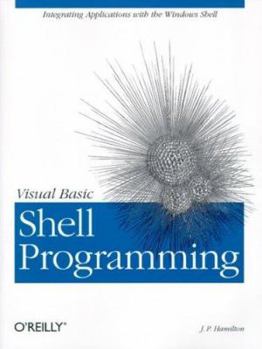VB Shell Programming (Visual Basic)
Visual Basic's outstanding set of resources for rapidly developing stand-alone applications doesn't include shell extensions for integrating those applications or their data files with the Windows... This description may be from another edition of this product.
Format:Paperback
Language:English
ISBN:1565926706
ISBN13:9781565926707
Release Date:July 2000
Publisher:O'Reilly Media
Length:392 Pages
Weight:1.45 lbs.
Dimensions:0.9" x 7.0" x 9.2"
Customer Reviews
5 ratings
Good Introduction to Shell Programming in VB
Published by Thriftbooks.com User , 23 years ago
First off, if all what you want to do is to add an icon to the systray, go find _any_ Win32 API book or even search on the web. This book does not cover simple tricks like this. But if you want to write your own namespace extensions or property sheet handlers, read on.Many people think VB and windows shell programming don't mix very well. Honestly, I was one of them. But after reading this great introduction, I figured I was wrong. Well, mostly wrong.There are two issues that make shell programming hard in VB: (1) As in most "advanced VB programming tasks", the first realization must be you _can't_ do it in pure VB. You need to import Win32 APIs and then fake you are writing your program in C. But that's a very old and well-solved problem, and in fact this book assumes you know how to do it: it shows the import statements without explaining how to get them. But that's fine, for I think most advanced VB programmers have already picked up this old trick.(2) The windows shell is built heavily on COM, so must be the shell extensions. But this book is not about writing COM servers in VB... Apparently the author did not expect the readers to know COM before, so he offered a short chapter on COM basics that I find too short to be sufficient for the purpose of this book. For example, later on he started using jargons like "in-process COM servers" and "apartment threaded" (these are COM jargons) without explaining what they are. I tried to look up these terms in the index to quote the page number. They are absent---yet another proof of insufficient coverage of COM. I admit that shell extensions are in-process COM servers and so in most cases the readers are not expected to do anything else anyway, but this kind of treatment much weakens a reader's understanding of what he/she is doing.And there are other problems that plague this almost excellent book:(1) There is no separate treatment of what should the programmer do when a new shell extension comes out. As an example, icon overlay is not covered in this book. I think this is really the major reason I have to take half a star off: this book is more like "how I wrote those shell extensions" rather than "how you can write your own ones". For example, it does show many examples of how to turn a given IDL into more VB friendly, but not how can the programmer obtain the IDL of an interface that's not covered in the book. (OLE View won't answer all such prayers. Go check the platform SDK or, _cough_, wait for the second edition of the book to have a new chapter on that extension. :P) (2) There is no coverage of debugging shell extensions. It's not as easy as one may expect, especially as VB will automatically re-register your COM servers when you execute your code while Explorer loads some registry entries only once... Overall, this is a more than decent introduction to shell programming using VB. If you want to do some typical shell programming like having your own property sheet or namespace extensions, then
Awsome Book !!
Published by Thriftbooks.com User , 24 years ago
A must read for those who like to push VB beyond the limits, previously viewed as 'impossible to do in VB'. Very well organized and lots of examples.Excellent reference material and a worthly investment.
Not neccessary but fun to read
Published by Thriftbooks.com User , 24 years ago
Visual Basic and Shell Extension? I thought it should be Visual C++'s territory. The book proves Visual Basic can do anything as Visual C++ can. It might take more works to finish the same task compared to Visual C++ but the experience is simply rewarding and fun.
Everything I thought Visual Basic Couldn't Do...
Published by Thriftbooks.com User , 24 years ago
Working with Visual Basic you stay away from doing certain things. Namespace Extensions was one of those things for me. Then I found this book. I have learned more about how Windows and Viusal Basic works from reading this book than any other thing I have ever done. Way to go J. P. Hamilton! Hats off to you. This is a must read book, even if you never have the need to work with the shell.
Just what the doctor ordered
Published by Thriftbooks.com User , 24 years ago
As a Visual Basic developer, I always envied C++ developers who were able to do Namespace extensions, as well as other integrations with the Windows Shell. Well the wait is over, and now there is a book which explains it all. Never before there has been such a source of information for the Visual Basic developers. We were in the dark. I remember trying to implement the C++ code, and port it to Visual Basic, only to find one obstacle after another. This book clearly explains the steps and API's needed to perform this task. Using and enhancing Windows Shell can be a great supplement to the GUI programming.





